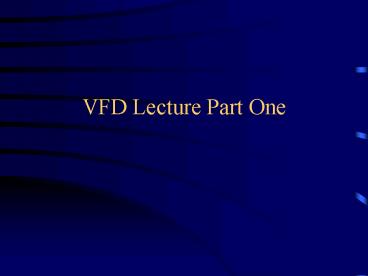VFD Lecture Part One - PowerPoint PPT Presentation
1 / 31
Title: VFD Lecture Part One
1
VFD Lecture Part One
2
Evaluation and Treatment of Visual Field Deficits
3
Lecture Objectives
- Correlates lesion site with specific VFD
- Describes changes in occupational performance
caused by VFD - Describes adjustment related to VFD
- Describes treatment intervention for specific
performance deficits - Demonstrates correct testing procedure and
interpretation
4
The Visual Field
- Area of visual world that can be seen
- when looking straight ahead
5
The Visual Field cont
- Captured initially by the retina
- Mapped out in several areas of CNS during visual
processing - Superior colliculi
- Lateral geniculate nucleus
- Geniculocalcarine tracts
- Occipital pole
6
Sensitivity of visual field is mapped out as a
field diagram
7
Geographic Markers
- Divided into quadrants
- with fovea in the center
- Superior and inferior
- Nasal and temporal
- Lateral crescent
- Crescent shaped area
- marked by dotted line
8
Sensitivity Markers
Central field fovea and macula
9
Sensitivity Markers
Peripheral or paracentral field
10
Sensitivity is mapped out as an isopter
- Defines the hill of vision
- Provides a 3-D map of
- visual sensitivity
- Isopters depict boundary
- between region where the
- target is visible and where
- it is not visible
isopters
11
The Visual Field is Binocular
12
Visual field deficit is the most common visual
impairment following brain injury
Most VFD results from lesions along
genicul- calcarine tract (GCT) or in occipital
pole (OP) Most result from posterior cerebral
artery occlusion (PCA) Middle cerebral artery
occlusion can also cause
GCT
OP
13
PCA Lesion
- 75 result in homonymous hemianopsia
- 70 with complete hemifield impairment
14
- Macular field sparring may occur in 30
15
Other Causes of Visual Field Deficits
- Anoxia
- Can create bilateral field constriction (tunnel
vision) - Central retinal artery occlusion
- Glaucoma
- Multiple sclerosis
16
Perimetry Testing
- All testing involves three components
- Sustained fixation on a central target
- Presentation of a second target of a specified
size/luminosity in a designated area of the field - Acknowledgment of the second target without
breaking fixation on the central target
17
Testing Defines the Visual Sensitivity of the
Field
- Every point within the retinal visual field has a
specific visual threshold - Defined as the weakest test stimulus just visible
in that location under the specific test
conditions - Indicates the sensitivity of the photoreceptors
to stimuli - Mapped out as isopters
- Threshold levels vary within the field
- Hill of vision concept
- Lowest at the fovea
- Highest at the periphery
18
Circles represent isopters in the field diagram
19
Static vs Kinetic Test Strategy
- Static
- Target appears in a specified location without
moving to that location - Kinetic
- Target is moved into a specified area of the
field until it is detected and acknowledged
20
Threshold vs. Screening Test Strategy
- Threshold
- target is presented in specific location in field
and increased in intensity until it becomes
visible - Very accurate, discrete measurement
- Screening
- Target is presented one time at supra-threshold
value
21
Various Perimetry Tests
- Screening
- Confrontation test
- Manual
- Tangent screen
- Damato campimeter
- Bowl (measure central and peripheral)
- Automated Humphrey Visual Field Analyzer
- Manual Goldmann perimeter
- Real Time
- Scanning laser ophthalmoscope
- Macular field only
22
Screening Confrontation Tests
Red Dot Test
Finger Confrontation
- Quick bedside maneuver
- Provides gross indication of deficit
- Estimate how much field is missing based on
comparison - to examiners field
- Unreliable
23
Manual Perimeters
Tangent Screen
- Quick and inexpensive
- Requires skilled examiner
- Measures only central
- field
Damato Campimeter
- Portable
- Reliable
- Measures only central
- field
24
Bowl Perimeters
Humphrey Visual Field Analyzer
Goldmann Manual Bowl Perimeter
Patient
Examiner
- Central and peripheral field
- Accurate, comprehensive
- Picks up subtle deficits
- Field diagram easy to interpret
- Not readily available
- Central and peripheral field
- Requires skilled examiner
- Field diagram drawn in isopters
- Not readily available
25
Real Time Perimetry
Scanning Laser Ophthalmoscope
- Images retina in real time
- using Hene laser
- Allows discrete measurement
- of scotomas 5 degrees or less
- Most reliable, accurate form
- of perimetry
- But only measures central
- 20 degrees of field
26
Interpretation of Visual Field Testing
- Different pathologies are characterized by losses
in different areas of the field - Central scotomas
- Paracentral scotomas
- Peripheral losses
- Hemianopsias, quadrantanopsias
- Also characterized by denisity
- Absolute
- completely non functioning retina
- Relative or threshold
- Retina still has some capability for function
27
Interpretation of Perimetry Tests
- Visual field is plotted on a field diagram
- Visual field degrees 60 superiorly, 75
inferiorly, 100 temporally, 60 nasally - Diagrams come in different formats
- Isopters
- Absolute scale
- Gray scale
28
Isopter Diagram
isopter
Seen area
- Isopter boundary between a region where a target
is visible and where it is not visible - Functioning retina lies inside the isopter
29
Absolute Scale Diagram
- Uses symbols to describe sensitivity of field
- One symbol indicates loss
- Another symbol indicates decreased sensitivity
- Each perimeter will have its own legend
30
Gray Scale Diagram
- Sensitivity of field is described using different
shades of gray - Light shadinghigh threshold, can detect small
target - Black shadingno response to target
31
- Threshold tests
- Will have several isopters or symbols
- Depicting varying sensitivity of the field
- Screening tests
- Will have one isopter or one set of symbols
- Depict only areas of intact and impaired retinal
function































